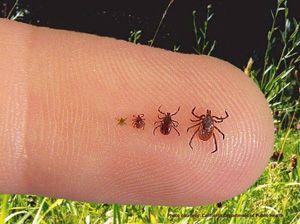Ticks in dogs appear as small, dark, and oval-shaped insects, ranging in size from a pinhead to a pea. They often attach themselves to the skin, feeding on the dog’s blood.
Ticks can be distinguished by their eight legs and round body. These parasitic pests can be found in various areas of a dog’s body, such as the ears, neck, and between the toes. Additionally, ticks can transmit diseases such as Lyme disease and Rocky Mountain spotted fever, posing a significant health risk to dogs.
It’s crucial for pet owners to regularly check their dogs for ticks and promptly remove them to prevent potential health issues. Understanding the appearance of ticks is essential for effective tick prevention and maintenance of a dog’s well-being.
Recognizing Ticks On Your Canine Companion
Introduction to ticks on dogs: Ticks are small, blood-sucking parasites that can cause a range of health problems for dogs and their owners. Recognizing ticks on your canine companion is crucial for preventing tick-borne diseases. These parasites can be found in various environments, including wooded areas, fields, and even urban parks. It’s important for dog owners to understand the varieties of ticks found on dogs to effectively combat and prevent tick infestations. The most common tick species that affect dogs include the American dog tick, brown dog tick, black-legged tick, and the Lone Star tick.
Identifying Ticks Amongst Dog Fur
When checking your dog for ticks, it’s important to recognize their physical characteristics. Ticks vary in size and color, with some species being as small as a poppy seed and others as large as a pencil eraser. Their color can range from brown to reddish-brown or even gray when engorged with blood. When comparing them with other insects, ticks have a distinct body structure with eight legs and lack wings. It’s crucial to be able to distinguish ticks from other bugs to effectively remove them from your dog’s fur and prevent potential health issues.
What Does A Tick Look Like In A Dog: Spotting Telltale Signs
A tick on a dog can vary in appearance, depending on its life stage. Adult ticks have a reddish-brown oval body, while nymphs are smaller and lighter in color. Ticks can be found in various places on a dog’s body, including the ears, in between toes, and within skin folds. They latch onto the skin and feed on the dog’s blood, potentially leading to discomfort and skin irritation. If overlooked, ticks can lead to health issues such as Lyme disease and anemia in dogs. Regularly checking your dog for ticks, especially after outdoor activities, is essential for preventing any potential health consequences.

Credit: dec.alaska.gov
Steps For Safe Tick Inspection
When inspecting your dog for ticks, it’s important to be thorough and methodical. Start by preparing for the search by gathering a pair of fine-tipped tweezers and a container of rubbing alcohol. Next, approach the inspection with a systematic approach, starting from the head and moving downwards. Carefully part your dog’s fur and examine the skin for any signs of ticks. If you find a tick, use the tweezers to grasp it as close to the skin as possible and pull it out with a steady motion. After removing the tick, place it in the container of rubbing alcohol to ensure it is dead. Lastly, monitor your dog for any signs of illness and consult a veterinarian if necessary.
Preventative Measures To Protect Dogs
Sure, I can provide the information in HTML format. Here’s the content for the blog post:“`htmlRegular grooming habits such as brushing and inspecting your dog’s fur can help you identify ticks early. Use tick repellents with veterinarian approval and follow the recommended usage guidelines. Additionally, scheduling regular check-ups with a veterinarian is crucial for the early detection of tick-borne diseases. Keep an eye out for any unusual behavior and seek professional help immediately if you suspect a tick infestation.
Frequently Asked Questions On What Does A Tick Look Like In A Dog
What Does A Tick Look Like On A Dog?
Ticks appear as small, dark, and round parasites attached to the dog’s skin. They vary in size, resembling a poppy seed or a small wart. Ticks can expand when feeding, turning into a swollen, reddish-brown lump. It’s important to promptly remove them to prevent diseases.
How To Identify Ticks On Dogs?
Inspect your dog’s fur, especially in their ears, paws, and armpits, for tiny, round parasites. Run your fingers over their skin to feel for lumps that could be ticks. Look for dark, raised, or swollen areas on their skin. Regular grooming and tick checks can aid in prompt identification.
Are Ticks Dangerous To Dogs?
Yes, ticks pose significant health risks to dogs. They can transmit various diseases such as Lyme disease and Rocky Mountain spotted fever. Additionally, the toxins in tick saliva can cause paralysis in dogs. Early detection and prevention are crucial in safeguarding your dog’s well-being.
How To Remove Ticks From Dogs?
Use fine-pointed tweezers to grasp the tick close to your dog’s skin. Gently pull straight upward, ensuring to remove the entire tick, including its mouthparts. Refrain from twisting or jerking the tick while pulling. Afterward, clean the area and monitor for any signs of infection.
Conclusion
Recognizing what a tick looks like in your dog is crucial for their health. Regular checks and immediate removal are key. By being proactive, you can prevent tick-borne diseases and keep your furry friend healthy and happy. Stay vigilant and informed to ensure your dog’s well-being.



